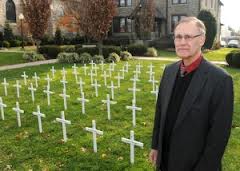We have all seen them along the highways: crosses marking the loss of a loved one. As we speed by, we are momentarily reminded of the fragility of life, the sorrows that flow from loss, the desperate effort to remember.
 Were such emblems planted where homicide ended lives in Camden in 2012, they would pile up in hardscrabble neighborhoods—North Camden, Waterfront South, and Whitman Park. As it is, the Google map of these deaths show a concentration of death by violence beyond comprehension in almost any other place we could imagine.
Were such emblems planted where homicide ended lives in Camden in 2012, they would pile up in hardscrabble neighborhoods—North Camden, Waterfront South, and Whitman Park. As it is, the Google map of these deaths show a concentration of death by violence beyond comprehension in almost any other place we could imagine.
Such losses generate their own markers, first the telling yellow tape, then maybe graffiti on a nearby abandoned building. As much as they become a part of the local landscape, such signs remain largely invisible to outsiders, whose momentary experience is more likely to come in a fleeting headline than in a physical encounter.
As the city marched inexorably toward the horrific record for homicides in a single year, a Camden activist organization, Stop Trauma on People, responded. These deaths would not be forgotten. They would be made visible. For every death, there would be a cross, and these would all be gathered together in the park created only recently to provide the city a public commons in the shadow of the seat of city and county government.
A Camden city councilman objected. This was not the message the city wanted to send to the outside world. One well-meaning person who works in the city but resides elsewhere reacted by sponsoring a billboard that got as much attention as nearly any one of the homicides. It urged its audience to “Say Something Nice About Camden.”
Thirty years earlier, as the city tried to dig out of its horrendous post-industrial hole through an extensive program of physical redevelopment, officials erected a sign with an equally telling message, “Pardon Our Appearance and the Inconvenience While Camden Changes its Image.”
What pretention, we can reflect from the vantage point of a further generation’s worth of expectations raised and dashed. Would that a city could willfully pull itself out of its malaise by tearing some buildings down, putting a few more up, and telling the world to come on by, proclaiming “Camden is open for business.”
Like those roadside markers, the latest memorials in Camden attracted personal  touches—a stuffed animal clinging to one marker, flowers and pictures of remembrance at others. At year’s end, with every one of the 67 crosses numbered and the victims accounted for, each was remembered for an hour. The ceremony lasted three days.
touches—a stuffed animal clinging to one marker, flowers and pictures of remembrance at others. At year’s end, with every one of the 67 crosses numbered and the victims accounted for, each was remembered for an hour. The ceremony lasted three days.
These efforts did attract the attention they sought. Media reports followed, not just in Camden, but from across the state and national broadcasters in New York. Commentators vested hope in an expanded county police force that would put more feet on the ground. Activists behind the memorial wanted something more fundamental: an assault by the living on the poverty that lay behind the killings.
Among the responses were the erection of companion fields of crosses, among them St. Joe’s Prep in Philadelphia, Christ Our Light Church in Cherry Hill, and Our Lady of  Good Council Church in Moorestown. Some there remembered, no doubt, the ABC television show, which opened several years ago with a contrast between Moorestown, recently named one of America’s most livable cities, and Camden. Believed to have had some influence on Thornton Wilder’s Our Town, Moorestown has been the location of four homicides in the past forty years.
Good Council Church in Moorestown. Some there remembered, no doubt, the ABC television show, which opened several years ago with a contrast between Moorestown, recently named one of America’s most livable cities, and Camden. Believed to have had some influence on Thornton Wilder’s Our Town, Moorestown has been the location of four homicides in the past forty years.
Moorestown, and companion suburban areas, are not so far removed from Camden as they would like. It has been axiomatic that regions rise or fall as a whole. Camden’s continued struggle, the result as much as anything of the concentration of poverty in a sea of relative affluence, threatens all of us who know the city but remain relatively impervious to the way our relative privilege in the form of accumulated capital resources, including a more positive image than our neighboring city, has contributed to its struggles.
In 2005, to commemorate the publication of my book, Camden After the Fall, Rutgers-Camden hosted a conference on the city and its plight. Evoking the storm that devastated New Orleans earlier that year, urban critic David Rusk titled his talk “Hurricane Camden.” The parallels with Katrina were easy to draw, but like its own current victims, Camden was not attracting the kind of high-level attention its ongoing crisis deserved.
Is it so hard to imagine in the aftermath of Sandy President Obama joining Governor Christie for a tour Camden in the wake of its latest disaster? Their presence would not end the violence, but it would raise the stakes for providing more comprehensive and systemic responses. Since the record for homicide was last set in 1995, more than 700 people have been killed in Camden. This display at the heart of the city deserves more than passing attention.
(This essay was submitted December 14th, the day of the Newtown,CT tragedy, as part of the catalogue complementing the exhibit, “Visions of Camden,” currently running at the Rutgers-Camden Stedman Gallery).